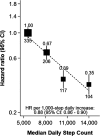Association of Daily Steps with Incident Nonalcoholic Fatty Liver Disease: Evidence from the UK Biobank Cohort
- PMID: 40279651
- PMCID: PMC7617666
- DOI: 10.1249/MSS.0000000000003738
Association of Daily Steps with Incident Nonalcoholic Fatty Liver Disease: Evidence from the UK Biobank Cohort
Abstract
Purpose: Low physical activity has been shown to be associated with a higher risk of nonalcoholic fatty liver disease (NAFLD). However, the strength and shape of this association are currently uncertain due to a reliance on self-reported physical activity measures. This report aims to investigate the relationship of median daily step count with NAFLD using accelerometer-derived step count from a large prospective cohort study.
Methods: The wrist-worn accelerometer substudy of the UK Biobank ( N = ~100,000) was used to characterize median daily step count over a 7-d period. NAFLD cases were ascertained via record linkage with hospital inpatient data and death registers or by using a measure of liver fat from imaging. Cox proportional hazards models were employed to assess the association between step count and NAFLD, adjusting for age, sociodemographic, and lifestyle factors. Mediation analyses were conducted.
Results: Among 91,031 participants (709,440 person-years of follow-up), there were 762 incident NAFLD cases. Higher step count was log-linearly and inversely associated with risk of NAFLD. A 1000-step increase (representing 10 min of walking) was associated with a 12% (95% confidence interval, 10%-14%) lower hazard of NAFLD. When using imaging to identify NAFLD, a 1000-step increase was associated with a 6% (95% confidence interval, 6%-7%) lower risk. There was evidence for mediation by adiposity, accounting for 39% of the observed association.
Conclusions: Daily step count, a modifiable risk factor, is log-linearly and inversely associated with NAFLD. This association was only partially explained by adiposity. These findings from a large cohort study may have important implications for strategies to lower NAFLD risk.
Keywords: ACCELEROMETRY; EXERCISE; PROSPECTIVE STUDIES; WALKING.
Copyright © 2025 The Author(s). Published by Wolters Kluwer Health, Inc. on behalf of the American College of Sports Medicine.
Figures



References
-
- Riazi K Azhari H Charette JH, et al. The prevalence and incidence of NAFLD worldwide: a systematic review and meta-analysis. Lancet Gastroenterol Hepatol. 2022;7(9):851–61. - PubMed
-
- Byrne CD, Targher G. NAFLD: a multisystem disease. J Hepatol. 2015;62(1 Suppl):S47–64. - PubMed
-
- Bugianesi E. Non-Alcoholic Fatty Liver Disease: A 360-Degree Overview. 1st ed. Cham (Switzerland): Springer; 2020. p. 362.
-
- Ge X Wang X Yan Y, et al. Behavioural activity pattern, genetic factors, and the risk of nonalcoholic fatty liver disease: a prospective study in the UK Biobank. Liver Int. 2023;43(6):1287–97. - PubMed
MeSH terms
Grants and funding
LinkOut - more resources
Full Text Sources
Medical

